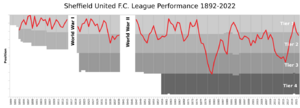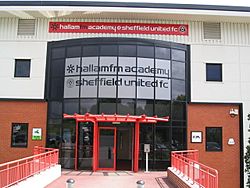Sheffield United F.C. facts for kids
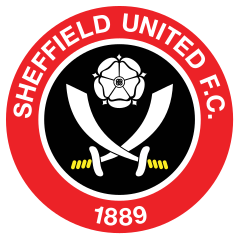 |
|
| Full name | Sheffield United Football Club |
|---|---|
| Nickname(s) | The Blades |
| Short name | SUFC |
| Founded | 22 March 1889 |
| Stadium | Bramall Lane |
| Capacity | 32,050 |
| Owner | COH Sports |
| Chairman | Steven Rosen and Helmy Eltoukhy |
| Manager | Rubén Sellés |
| League | Premier League |
| 2018–19 | Championship, 2nd of 24 (promoted) |
Sheffield United Football Club is a professional football team from Sheffield, England. They are known as "the Blades" because Sheffield is famous for making cutlery. The team plays its home games at Bramall Lane, their stadium since the club started.
For most of their history, Sheffield United has worn red and white striped shirts with black shorts. Their biggest rivals are Sheffield Wednesday. When these two teams play, it's called the Steel City derby.
Sheffield United was formed in 1889 from the Sheffield United Cricket Club. They quickly became successful in local leagues. In 1892, they were invited to join the new Football League Second Division. They were the first team to win promotion to the First Division in 1893.
The club became English football champions in 1897–98. They also won the FA Cup four times: in 1899, 1902, 1915, and 1925. They were also FA Cup finalists in 1901 and 1936.
United spent 41 years in the top league before being relegated in 1934. They won the Second Division title in 1952–53. The club moved between the top two divisions for the next three decades.
By 1982, they had dropped to the fourth tier of English football. However, they quickly bounced back, winning the Fourth Division title in 1981–82. This made them one of only five clubs to have won titles in all four professional English football divisions.
Sheffield United was one of the founding teams of the Premier League in the 1992–93 season. They even scored the first goal in the competition's history! They were relegated in 1994. After some years, they returned to the Premier League in 2006.
They were relegated again in 2007 and then dropped to League One in 2011. After six seasons in the third tier, they won promotion as champions in 2016–17 under manager Chris Wilder. They then earned promotion to the Premier League again in 2018–19.
The club returned to the Championship in 2021. They were promoted back to the Premier League in the 2022–23 season. However, they were relegated again in the following season.
Contents
Club History
Early Days and Success (1888–1975)
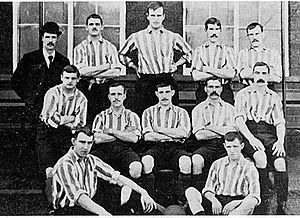
Sheffield United was started by members of the Sheffield United Cricket Club. This cricket club was formed in 1854 and was the first English sports club to use 'United' in its name. The football team's main nickname is "The Blades." This refers to Sheffield's history as a major producer of cutlery.
The club's first nickname was "The Cutlers" from 1889 to 1912. Their city rivals, Wednesday, used to be called "The Blades." But in 1907, Wednesday became "The Owls," named after their new stadium in Owlerton. After that, Sheffield United took on the "Blades" nickname.
Sheffield United officially began on March 22, 1889, at the Adelphi Hotel in Sheffield. This is now where the Crucible Theatre stands. The club was founded by Sir Charles Clegg, who was also the president of the Cricket Club. The Wednesday football team had moved from Bramall Lane after a disagreement about ticket money. So, the people who owned Bramall Lane needed a new team to play there and earn money.
The club's most successful period was between 1895 and 1925. During this time, they won the English championship in 1897–98. They were also runners-up in 1896–97 and 1899–1900. They won the FA Cup four times: in 1899, 1902, 1915, and 1925. Sheffield United has not won a major trophy since 1925.
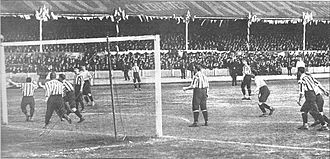
Tough Times and Comebacks (1975–1994)
The club faced difficult times between 1975 and 1981. After finishing sixth in the First Division in 1975, they were relegated the next season. Three years later, they dropped to the Third Division. In 1981, they reached their lowest point, being relegated to the Fourth Division.
However, they quickly recovered. They won the Fourth Division title in their first season there (1981–82). Two years later, they were promoted to the Second Division. They fell back to the Third Division in 1988.
New manager Dave Bassett helped the team bounce back quickly. They achieved back-to-back promotions, returning to the First Division in 1990 after 14 years away. They stayed in the top league for four seasons. They were even founding members of the new Premier League in 1992. They reached an FA Cup semi-final in 1992–93 before being relegated in 1994.
Financial Challenges and League One (1994–2013)
Sheffield United stayed out of the top league for the next 12 years. They reached the play-offs in 1997 and 1998. In December 1999, Neil Warnock became manager. The club faced financial problems, making it hard to improve the team.
However, in 2002–03, they had a great season. They reached the semi-finals of both domestic cups and the Division One play-off final. Three years later, Warnock led the Blades back to the Premier League. They finished second in the Championship.
They only stayed in the Premier League for one season. They were relegated in 2007 after a controversial player signing by West Ham United. Neil Warnock then left as manager. In 2006, the team also bought a Chinese club, Chengdu Wuniu, and renamed it "Chengdu Blades." This team was later dissolved in 2015.
The club struggled after returning to the Championship. They had high player wages but the team's performance didn't match. They also had many different managers in a short time. In 2009, they reached the Championship play-off final but lost.
The 2010–11 season was very difficult. The club had three different managers and was relegated to League One. This meant they were in the third tier of English football for the first time since 1989. United reached the League One play-offs in 2011–12 and 2012–13 but lost in the final and semi-final.
New Ownership and Premier League Returns (2013–2024)
In September 2013, Abdullah bin Mosaad Al Saud bought a 50% share in the club's parent company. In 2014, United reached the FA Cup semi-finals at Wembley Stadium but lost to Hull City. In 2014–15, they reached the FA Cup quarter-finals and the League Cup semi-finals.
United won promotion back to the second tier in the 2016–17 season. This was under the management of Chris Wilder, a lifelong fan and former player. They won the League One title with 100 points. In 2017, there was a disagreement between the co-owners, which went to court.
In the 2018–19 season, Sheffield United earned automatic promotion to the Premier League. Many expected them to be relegated, but they finished ninth in their first season back. In September 2019, after a long legal battle, Prince Abdullah became the sole owner of the club.
The 2020–21 season was very tough. The team won only one of their first 18 matches. Chris Wilder left the club in March 2021. Paul Heckingbottom took over as caretaker manager, but the team was relegated at the end of the season. In May 2021, Slaviša Jokanović became the club's first overseas manager. However, he was dismissed in November 2021 after a poor start. Heckingbottom was then reappointed as manager permanently.
In the 2021–22 season, United finished fifth in the Championship but lost in the play-off semi-finals. In the 2022–23 season, Heckingbottom guided United back to the Premier League, finishing second. The team also reached the FA Cup semi-finals, losing to Manchester City.
Sheffield United's return to the Premier League for the 2023–24 season was difficult. By early December, they were at the bottom of the league. Paul Heckingbottom was sacked and replaced by Chris Wilder. Despite the change, the team's poor form continued. Their relegation back to the Championship was confirmed on April 27, 2024. They set a new Premier League record for most goals conceded in a single season, with 104 goals.
Team Kits, Colours, and Crest

Sheffield United has mostly played in red and white stripes. However, they first played in white shirts and blue shorts. They briefly wore narrow red stripes in 1890–91 before returning to all-white. The stripes came back in 1892–93, and black shorts replaced blue ones in 1904.
The shirts have changed slightly over the years, with different neck styles. In the 1974–75 season, black elements were added. Later, some kits were white with a red breast and thin stripes to show sponsors' logos. Since then, red and white stripes with black shorts and socks have been the main look. Sometimes, thin black stripes are added between the red and white ones.
Sheffield United's home colours inspired the kit of Irish club Derry City. In 1934, Derry City adopted the stripes because of Billy Gillespie's achievements at Sheffield United when he was their manager.
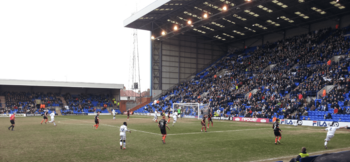
The first time a crest appeared on the shirt was in the 1891–92 season. It was a red crest on a white shirt, but it disappeared the next season. From 1965 to 1977, United used the city of Sheffield's coat of arms.
In 1977, a new crest was introduced. It was designed by former player Jimmy Hagan many years before. This crest has two white crossed swords, or blades, which is the club's nickname. Above them is a Yorkshire Rose on a black background. This is surrounded by a red ring with "Sheffield United F.C." written at the top and "1889," the year the club was founded, at the bottom. This crest has been slightly changed a few times but returned to its original form in 2000.
Shirt Sponsors and Manufacturers
| Year | Kit manufacturer | Main shirt sponsor | Secondary sponsor |
|---|---|---|---|
| 1973–75 | Umbro | None | None |
| 1975–79 | Admiral | ||
| 1979–81 | Hobott | Cantor's | |
| 1981–82 | Bentleys | ||
| 1982–83 | Renault | ||
| 1983–85 | Umbro | Simonds | |
| 1985–95 | Arnold Laver | ||
| 1995–97 | Avec | Wards | |
| 1997–99 | Le Coq Sportif | ||
| 1999–2000 | Blades | ||
| 2000–02 | Patrick | Midas Games | |
| 2002–04 | Le Coq Sportif | Desun | |
| 2004–06 | HFS Loans | ||
| 2006–07 | Capital One | ||
| 2007–08 | Valad | ||
| 2008–09 | VisitMalta.com | ||
| 2009–11 | Macron | Capita | |
| 2011–12 | Westfield Health (Home) Gilder Group/Volkswagen (Away) |
Nexis Holdings PLC | |
| 2012–13 | Westfield Health (Home) Redtooth (Away) |
GCI Com | |
| 2013–14 | VSports (Home) Top Spring (Away) |
Football Manager Shebang |
|
| 2014–16 | Adidas | John Holland Sales | DBL Logistics |
| 2016–17 | Alpha Rooms | Door Deals | |
| 2017–18 | Teletext Holidays | ||
| 2018–19 | Ramsdens Currency | ||
| 2019–21 | Union Standard Group | Union Standard Group | |
| 2021–22 | Randox | Door Deals | |
| 2022–23 | Erreà | Ultimate Champions | |
| 2023–24 | CFI Financial Group | Gtech | |
| 2024–25 | Maneki | DR CINIK |
Home Ground: Bramall Lane
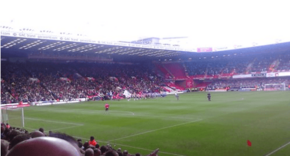
A near-full capacity South Stand and adjacent Bramall Lane Stand at Bramall Lane
|
|
| Location | Sheffield, South Yorkshire, England |
|---|---|
| Coordinates | 53°22′13″N 1°28′15″W / 53.37028°N 1.47083°W |
| Owner | Sheffield United |
| Capacity | 31,884 |
| Opened | 30 April 1855 |
Sheffield United plays at Bramall Lane, which is close to the centre of Sheffield. Bramall Lane is the oldest major league football ground in the world. It hosted its first game in 1862. This was a match between Hallam and Sheffield Club.
Bramall Lane also hosted the world's first ever floodlit football match. This happened on October 14, 1878. Two teams from the Sheffield Football Association played under lights. The power for the lights came from two generators. About 20,000 people watched the game.
Bramall Lane was originally a cricket ground. In 1855, it was leased to Sheffield United Cricket Club. The ground opened with a cricket match on April 30, 1855. Later, it became a shared ground for both cricket and football. Yorkshire County Cricket Club used it as their main venue in the 1800s. They continued to use it for some matches until 1973. After that, work began to turn Bramall Lane into a stadium just for football.
The stadium has been expanded in recent years. In 2006, a new 3,000-seat stand was completed. Bramall Lane is now an all-seater stadium with a capacity of 31,884. This makes it suitable for Premier League matches.
In March 2009, the club received permission to expand the stadium again. The first phase would have extended the Kop stand to about 37,000 seats. It would also have removed supporting pillars and added a giant screen. The second phase would have extended another stand, bringing the total capacity to 40,000. These plans were also meant to help the stadium be chosen for FIFA World Cup matches. However, in December 2009, it was announced that any World Cup games in Sheffield would be at Sheffield Wednesday's Hillsborough Stadium. Because of this, the club put all redevelopment plans on hold. They decided to wait until the club could stay in the Premier League.
A new plan for the Kop stand was submitted in 2015. This would add 3,215 seats. Further plans were revealed in 2017 for the corner between the Kop and South Stand. These plans included building residential flats and a new club shop.
Fans and Rivalries
Sheffield United has many supporters from Sheffield and the surrounding areas. There are official fan clubs in places like Swinton and Eckington. There are also fan groups further away, including in Essex, the Republic of Ireland, the Netherlands, and Australia.
A study in 2013 found that Sheffield United fans have the most positive interactions with their club's official social media account. Another study in 2006–07 found that Blades fans were the most 'obsessed' in the Premier League. Supporters reportedly thought about the team 110 times a day on average!
Some famous people who support Sheffield United include:
- Sean Bean, actor
- Kell Brook, boxer
- Jessica Ennis-Hill, Olympic gold-medallist
- Flea, singer and actor
- Matt Fitzpatrick, golfer
- Joe Root, England cricketer
- Juan Sebastián Verón, former Argentina international footballer
Rival Teams
Sheffield United has several rivalries, mostly with other teams from Yorkshire. Their biggest rivalry is with their city neighbours, Sheffield Wednesday. This match is called the Steel City derby, named after Sheffield's famous steel industry.
Another main rival is Leeds United from West Yorkshire. This is known as a Yorkshire derby. Other local rivalries are with teams from South Yorkshire: Barnsley, Doncaster Rovers, and Rotherham United. These are called South Yorkshire derbies.
Sheffield United also has a rivalry with Nottingham Forest. This rivalry started during the miners' strikes in the 1980s. Miners in Nottinghamshire did not join the strike, while miners from Yorkshire did.
West Ham United has also become a rival. This is due to a controversial player signing and a lawsuit that followed.
Team Songs
Like many English clubs, Sheffield United supporters have many chants and songs. The most famous one is The Greasy Chip Butty Song. It is sung to the tune of John Denver's 'Annie's Song'.
Records and Statistics
- Biggest League Win: 10–0 away against Port Vale, Division Two, December 10, 1892. Also 10–0 home against Burnley, Division One, January 19, 1929.
- Biggest Cup Win: 6–0 home against Leyton Orient, FA Cup 1st Round, November 6, 2016.
- Biggest League Loss: 0–8 home against Newcastle United, Premier League, September 24, 2023.
- Biggest Cup Loss: 0–13 home against Bolton Wanderers, FA Cup 2nd round, February 1, 1890.
- Highest Home Attendance: 68,287 against Leeds United, FA Cup 5th round, February 15, 1936.
- Most League Games Played: Joe Shaw played 631 games between 1948 and 1966.
- Most Goals Scored Overall: Harry Johnson scored 201 goals in 313 games between 1919 and 1930.
- Most Goals in a Season: Jimmy Dunne scored 41 goals in 41 games, Division One, 1930–31.
- Record Transfer Fee Paid: £23.5 million for Rhian Brewster from Liverpool on October 2, 2020.
- Record Transfer Fee Received: £11.5 million for David Brooks to AFC Bournemouth on July 1, 2018.
League History
|
|
|
|
|
- Seasons spent at Level 1 of the football league system: 62
- Seasons spent at Level 2 of the football league system: 44
- Seasons spent at Level 3 of the football league system: 11
- Seasons spent at Level 4 of the football league system: 1
| Season | League | Pos | P | W | D | L | F | A | Pts |
|---|---|---|---|---|---|---|---|---|---|
| 2015–16 | League One | 11 | 46 | 18 | 12 | 16 | 64 | 59 | 66 |
| 2016–17 | League One | 1 | 46 | 30 | 10 | 6 | 92 | 47 | 100 |
| 2017–18 | Championship | 10 | 46 | 19 | 8 | 15 | 57 | 49 | 65 |
| 2018–19 | Championship | 2 | 46 | 26 | 11 | 9 | 78 | 41 | 89 |
| 2019–20 | Premier League | 9 | 38 | 14 | 12 | 12 | 39 | 39 | 54 |
| 2020–21 | Premier League | 20 | 38 | 7 | 2 | 29 | 20 | 63 | 23 |
| 2021–22 | Championship | 5 | 46 | 21 | 12 | 13 | 63 | 45 | 75 |
| 2022–23 | Championship | 2 | 46 | 28 | 7 | 11 | 73 | 39 | 91 |
| 2023–24 | Premier League | 20 | 38 | 3 | 7 | 28 | 35 | 104 | 16 |
| 2024–25 | Championship | 3 | 46 | 28 | 8 | 10 | 63 | 36 | 90 |
Players
First Team Squad
|
|
Players on Loan
|
Player of the Year Award
| Year | Position | Name |
|---|---|---|
| 2020–21 | Goalkeeper | |
| 2021–22 | Midfielder | |
| 2022–23 | Midfielder | |
| 2023–24 | Midfielder | |
| 2024–25 | Goalkeeper |
The 'Player of the Year' award has been given out since 1967. It celebrates the player who has contributed the most to the club during the season. Fans vote for this award. It is now presented at a special 'End of Season' event.
The first winner was goalkeeper Alan Hodgkinson. Striker Alan Woodward has won the award the most times, with four wins between 1970 and 1978. Harry Maguire and Phil Jagielka have won the award three times in a row. In 2017, the award was shared for the first time by Billy Sharp and John Fleck. In 2024, it was won by an overseas player for the second year in a row, with Iliman Ndiaye winning in 2023 and Gustavo Hamer in 2024.
Youth and Women's Teams
Academy
Sheffield United's Academy helps young players develop their skills. It has produced famous players like Manchester City defender Kyle Walker and Phil Jagielka, both of whom played for the England national team. Other players from the academy include Harry Maguire and current club captain Billy Sharp.
The academy building and training facilities are in Shirecliffe, Sheffield. They opened in 2002. The Sheffield United Academy U18s play in the Professional Development League. They were runners-up in the 2011 FA Youth Cup. SteelPhalt sponsors the Academy and also sponsors Sheffield United Women.
Under 23s
Sheffield United U23s play in the Professional Development League. They play their home games at different places, including Bramall Lane. The club has had a reserve team since 1893.
United Women
Sheffield United also has a Women's team. They play in the FA Women's Championship. They were promoted to this league in the 2017–18 season. Sheffield United Women also have a Development team and many junior teams.
Club Management
Coaching and Support Staff
|
Owners, Directors, and Executives
|
Club Managers
When Sheffield United started in 1889, they didn't have a manager like today. A trainer coached the team, and a committee chose the players and tactics. Joseph Wostinholm was the club secretary. He managed the daily running of the club, including matches and player contracts. He saw the team grow quickly and win their only First Division championship in 1898.
After Wostinholm, John Nicholson became secretary. He stayed for over 30 years until he passed away in 1932. Nicholson was in charge during the club's most successful period. United became a top team in English football, winning the FA Cup four times.
A New Era of Managers
After John Nicholson passed away, Teddy Davison became the club's first official manager. The team was struggling and was soon relegated for the first time. Davison slowly rebuilt the team with smart signings and young players. He helped them return to the top league.
Davison retired in 1952. Reg Freeman took over and made the team stable. But he became ill and passed away in 1955. Then, Joe Mercer became manager, but he struggled with the team and left in 1958.
John Harris became manager next. He took a talented but underperforming team and turned them into a promotion-winning side. They returned to Division One in 1961. Harris built a team with local players and kept them in the top league. However, financial problems meant key players had to be sold, and United was relegated again. Harris moved to a 'general manager' role, and Arthur Rowley became team manager. But Rowley was sacked after one season. Harris returned as manager and led the team to promotion again. He stepped down in 1973.
Difficult Times and Comebacks
Ken Furphy became manager in 1973. He started well, but the team was getting older, and there wasn't much money for new players. After a good first season, a bad run of results led to Furphy being sacked in 1975. Jimmy Sirrel took over, but he was not popular and couldn't stop the team from being relegated. He was sacked in 1977.
Harry Haslam became manager next. He had many new ideas, but he built an aging team with 'star' players at the end of their careers. The team's performance got worse, and Haslam stepped down in 1981 due to illness. World Cup winner Martin Peters became manager, but United was relegated to Division Four, and Peters resigned.
Climbing Back Up
In 1981, Ian Porterfield became manager. He had an immediate impact, winning the Division Four championship in his first season. He took the club back to the second tier two years later. However, some fans were unhappy with the team's style of play, and Porterfield was sacked in 1986.
Billy McEwan became manager but didn't improve the team. He was sacked in 1988. Then, Dave Bassett took over. He couldn't prevent relegation in his first season, but he built a strong, hard-working team. He led the club to back-to-back promotions, returning them to the top league. With the start of the Premier League, the club's financial issues and selling of star players led to relegation. Bassett was sacked in 1995.
Modern Era Managers
The years that followed were challenging as United tried to get back to the Premier League. Howard Kendall became manager and rebuilt the team but left in 1997. Nigel Spackman and Steve Bruce also managed the team but left due to disagreements. Adrian Heath had a very short and unsuccessful time as manager.
Then, Neil Warnock became manager. He helped the team avoid relegation and slowly rebuilt it. Warnock led the team to promotion back to the Premier League in 2006. However, the team was relegated the next season, and Warnock's contract was not renewed.
Bryan Robson became manager in 2007 but was sacked after less than a year. Kevin Blackwell took over and reached the play-off finals in his first season. But the team declined, and he was sacked in 2010. Gary Speed briefly became manager but left to manage the Welsh national team. Micky Adams then became manager, but the team was relegated, and Adams was sacked.
In 2011, Danny Wilson became manager. He led the club to the League One play-off final in 2012, but they lost. Despite challenging for promotion the next season, Wilson left in 2013.
David Weir was appointed manager in 2013 but was sacked after only one win in 13 games. Nigel Clough then took over. He guided the Blades to seventh place in the league and an FA Cup semi-final in 2014. The next season, Clough led the Blades to fifth place and a League Cup semi-final. However, they failed to win promotion through the play-offs.
Clough was sacked in 2015. Nigel Adkins became the new manager but only lasted one season. He was replaced by former player Chris Wilder in 2016. Wilder led United to promotion from League One in 2017 and then to the Premier League in 2019.
United finished ninth in their first season back in the top league. But the 2020–21 season was very difficult. Wilder left the club in March 2021. U23 coach Paul Heckingbottom took interim charge, but United were relegated.
In May 2021, Slaviša Jokanović became the club's first overseas manager. However, he was sacked in November 2021. Heckingbottom was then appointed manager permanently. He guided United to the FA Cup semi-finals in 2023 and back to the Premier League for the 2023–24 season.
United struggled in the Premier League in 2023–24. Paul Heckingbottom was sacked in December 2023 and replaced by Chris Wilder.
Club Honours
League Titles
- First Division (Level 1)
- Champions: 1897–98
- Runners-up: 1896–97, 1899–1900
- Second Division / Championship (Level 2)
- Champions: 1952–53
- Promoted (2nd place): 1892–93, 1938–39, 1960–61, 1970–71, 1989–90, 2005–06, 2018–19, 2022–23
- Third Division / League One (Level 3)
- Champions: 2016–17
- Promoted (2nd place): 1988–89
- Promoted (3rd place): 1983–84
- Fourth Division (Level 4)
- Champions: 1981–82
- Football League North
- Champions: 1945–46
Sheffield United is the fourth club to have won a championship title in each of England's four professional leagues. The others are Burnley, Preston North End, and Wolverhampton Wanderers.
Cup Competitions
- FA Cup
- Winners: 1898–99, 1901–02, 1914–15, 1924–25
- Runners-up: 1900–01, 1935–36
- Sheriff of London Charity Shield
- Winners: 1898 (shared)
International Connections
In January 2006, Sheffield United became the first foreign club to take over a Chinese team. They bought Chengdu F.C., based in Chengdu, China. The club was renamed the Chengdu Blades. Sheffield United shirts were sold in China, and Chengdu shirts were sold in Sheffield. This helped both clubs earn more money. United sold their share of the Chinese team in 2010.
In February 2008, Kevin McCabe, the club's chairman, made a deal with Budapest-based Ferencváros to buy its football team. He also worked with the Hungarian government to buy and develop the land around their stadium. A match was played in Budapest to celebrate this connection. McCabe left the Fenecváros board in January 2011.
The Blades also have connections with other clubs around the world. These include Central Coast Mariners in Australia and White Star Woluwé in Belgium. In November 2020, they took over the club Quartz FC in Calicut, Kerala, India. This club plays in the third tier of Indian Football. They rebranded it as Kerala United FC.
Partner Clubs
 Arklow Town
Arklow Town Beerschot
Beerschot Buxton
Buxton Central Coast Mariners
Central Coast Mariners Estudiantes
Estudiantes Fenerbahce SK
Fenerbahce SK São Paulo
São Paulo Strindheim IL
Strindheim IL White Star Woluwé
White Star Woluwé Kerala United FC
Kerala United FC Al Hilal United (2020–present)
Al Hilal United (2020–present) LB Châteauroux (2021–present)
LB Châteauroux (2021–present)
See also
 In Spanish: Sheffield United Football Club para niños
In Spanish: Sheffield United Football Club para niños


